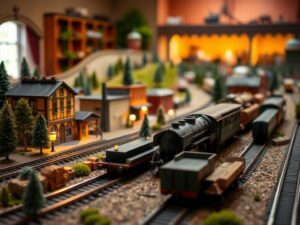Installing DCC Block Detection for HO Scale Layouts
Installing DCC Block Detection for HO Scale Layouts
Installing DCC Block Detection for HO Scale Layouts:
Welcome back, fellow railroad enthusiasts! Today, we’re diving into a topic that will significantly enhance your HO scale model railroading experience: DCC block detection. This powerful system not only allows for more realistic train operations but also unlocks exciting possibilities for automation and advanced signaling.
Let’s break down why DCC block detection is so essential and guide you through the process of installing it on your own layout.
Understanding Block Detection and DCC: The Foundations
Before we get our hands dirty, let’s establish a strong foundation by clarifying some key terms.
DCC (Digital Command Control)
DCC revolutionizes model railroading by giving you individual control over each locomotive and its functions like speed, direction, and even lighting. Unlike older systems that relied on fixed tracks and power controllers for entire trains, DCC utilizes digital signals transmitted along the track to communicate with each locomotive individually.
Blocks: Dividing Your Railway into Functional Units
In DCC, your layout is divided into “blocks” â sections of track that serve as logical units for control. Imagine them as individual city blocks connected by streets. Block detection tells the DCC system where each locomotive is located within these designated blocks.
Block Detection Sensors: The Eyes and Ears of Your Layout
The heart of the system lies in specialized sensors called block detectors. These miniature devices, strategically placed between track sections, monitor when a train enters or leaves a specific block.
Benefits of DCC Block Detection for HO Scale Layouts:
- Realistic Operation: Trains no longer appear to randomly jump from place to place. The system ensures they follow realistic routes and obey traffic signals (which we’ll get into later!).
- Enhanced Automation: You can program automatic switching sequences, route planning, and train movements, minimizing manual intervention.
- Advanced Signaling: DCC block detection lays the groundwork for sophisticated signaling systems that enhance realism and control.
- Data Tracking and Analytics: Many DCC block detection systems provide detailed information about train locations and movement patterns, helping you analyze your layout’s performance.
Types of DCC Block Detectors:
Choosing the right sensors for your layout is crucial. Here are some popular types available for HO scale models:
1. Rail Detectors: These sensors reside directly under the rails, utilizing small magnets or reed switches that activate when a train passes over them. They offer good reliability and compatibility with most DCC systems.
2. Under-Table Detectors: If space under your layout is limited, these detectors sit beneath the table, reading the movement of a passing train from below. They are often inductive sensors that detect changes in the magnetic field caused by the locomotive’s passage.
3. Bus-Powered Detectors:
These are self-powered units integrated into a central “bus” wire system, eliminating the need for separate wiring and power connections.
Installing DCC Block Detection on Your HO Scale Layout:
Now, let’s dive into the practical steps of installation:
Step 1: Plan Your Layout:
* Divide into Blocks: Visually map out your track plan and mentally divide it into logical blocks. Think about key points like stations, switches, junctions, and sidings.
* Determine Sensor Placement: Position detectors at entry/exit points for each block, considering visibility and accessibility. You typically need a sensor for the start and end of every block.
Step 2: Choose Your DCC Block Detection System:
* Analog vs. Digital: Digital block detection systems offer superior performance and control compared to older analog methods. Research reputable brands and read user reviews to find a system that suits your needs and budget.
* Some popular choices include: Digitrax, Lenz, ESU, MRC
Step 3: Wiring Connections (General Overview):
1. Connect the Bus Wire: Most DCC block detection systems use a dedicated “bus” wire or cables for communication between detectors and the central unit. Run these wires alongside your track circuit, ensuring secure connections at each detector.
2. Sensor Wiring: Follow the manufacturer’s instructions carefully to connect the sensors to the bus wiring or specific controller boards within the system. Often, they have separate wires for positive (red) and negative (black) power connections.
3. Power Connections:
a) Rail Feed: For standard DC systems, you may connect the power feed from your transformer directly to the track through dedicated block detection bus wire.
b) Dedicated DCC Booster/Power Supply: In more sophisticated setups with DCC command stations and boosters, ensure that your block detection system is powered appropriately by these components.
Step 4: Programming and Testing:
* Once everything is wired correctly, consult your DCC block detection system’s manual for specific programming instructions. You’ll typically need to configure the layout map, block boundaries, and any advanced features like signals or automation sequences.
Testing: Run a series of tests with individual locomotives to ensure each sensor activates accurately as trains pass through blocks. Double-check wiring connections and software settings if you encounter any issues.
Adding Realism with Advanced Features:
With your basic DCC block detection system set up, you can unlock further realism by incorporating these features:
-
Signals: Block detectors integrate seamlessly with DCC signaling systems, providing automatic signal control based on train movements within blocks. Red lights will display when trains enter occupied blocks, and green signals for clear track ahead.
-
Shunting & Yard Automation: Program your system to automatically move cars between tracks in a shunting yard or marshalling area. This simulates the complex movement of freight traffic and adds incredible detail to your operations.
Advanced Sensors (For Dedicated Enthusiasts):
If you want to delve deeper, consider adding specialized sensors like occupancy detectors (which can tell you if there’s a locomotive or rolling stock within a block) or track-condition sensors that monitor wheel flange contact.
Important Tips and Considerations for Success:
1. Insulation is Key:
Ensure your rail joiners and point insulators are properly insulated to prevent electrical shorts, especially if using AC-powered layouts.
2. Power Drops and Bus Lengths:
For large layouts or longer bus wire runs, consider incorporating power drops along the bus line to maintain consistent signal strength.
3. Software Updates and Documentation:
Stay up to date with the latest software for your DCC block detection system and consult online resources or user forums for helpful guides and troubleshooting tips.
4. Community Connections:
The model railroading community is incredibly supportive. Join online forums, attend club meetings, or even seek out mentorship from experienced modelers who can provide invaluable guidance on installation and programming techniques.
Conclusion: Taking Your HO Scale Model Railroad to the Next Level
Installing DCC block detection in your HO scale layout opens up a world of exciting possibilities for realism, automation, and advanced signaling. It may seem like a daunting task at first, but with careful planning, methodical wiring, and patience during programming, you’ll soon be enjoying the enhanced level of control and sophistication it offers.
Remember, this blog is your launchpad into this fascinating aspect of model railroading. There are countless resources available online, so don’t hesitate to delve deeper, ask questions in forums, and share your experiences with fellow hobbyists.
Happy Railroading!




